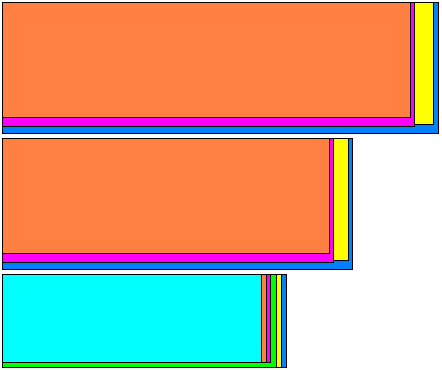Thoughts on narrower pitch keyboards?
Posted: 29 Dec 2013, 03:20
I was looking at some stuff to see whether some smaller layouts could take advantage of certain keys being smaller than they are now... and saw that the Alps switches are designed to handle 18 mm pitch, as well as the 19.05 mm pitch that's standard. Alps even sold keycaps designed for that pitch.
What are people's thoughts on going to narrower pitch to reduce keyboard size?
I'll note that I'm actually at my fastest on a slightly reduced pitch keyboard, and one of my favorite laptop keyboards was 18.5 mm pitch. (My fastest boards are my Tactile Pro 4, my Model F 122, and my Acer Aspire One at 17 mm pitch. I suspect that if there were good switches under it, I'd do much better.)
Edit: So, here, have some comparisons.

Top is full layout, middle is tenkeyless, bottom is 60%.
Blue is the "standard" full pitch layout - for full layout, that's 23 x 7 U, for tenkeyless, 18.5 x 7 U, and for 60%, 15 x 5 U.
Yellow is a mildly condensed layout - full layout is 22.75 x 6.5 U (although in reality, most keyboards would go to 23 x 6.5), tenkeyless is 18.25 x 6.5 U (again, 18.5 x 6.5 U would be more likely), and 60% is 14.75 x 5 U.
Green is an extremely condensed 60% layout, at 14.5 x 5 U. This causes problems for ISO layouts.
Purple is the standard layout, but at 18 mm pitch.
Orange is the mildly condensed layout, but at 18 mm pitch.
Teal is the extremely condensed 60% layout, but at 18 mm pitch.
What are people's thoughts on going to narrower pitch to reduce keyboard size?
I'll note that I'm actually at my fastest on a slightly reduced pitch keyboard, and one of my favorite laptop keyboards was 18.5 mm pitch. (My fastest boards are my Tactile Pro 4, my Model F 122, and my Acer Aspire One at 17 mm pitch. I suspect that if there were good switches under it, I'd do much better.)
Edit: So, here, have some comparisons.

Top is full layout, middle is tenkeyless, bottom is 60%.
Blue is the "standard" full pitch layout - for full layout, that's 23 x 7 U, for tenkeyless, 18.5 x 7 U, and for 60%, 15 x 5 U.
Yellow is a mildly condensed layout - full layout is 22.75 x 6.5 U (although in reality, most keyboards would go to 23 x 6.5), tenkeyless is 18.25 x 6.5 U (again, 18.5 x 6.5 U would be more likely), and 60% is 14.75 x 5 U.
Green is an extremely condensed 60% layout, at 14.5 x 5 U. This causes problems for ISO layouts.
Purple is the standard layout, but at 18 mm pitch.
Orange is the mildly condensed layout, but at 18 mm pitch.
Teal is the extremely condensed 60% layout, but at 18 mm pitch.
